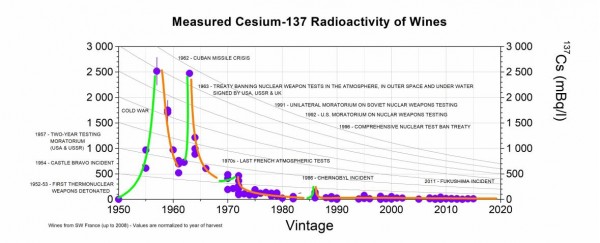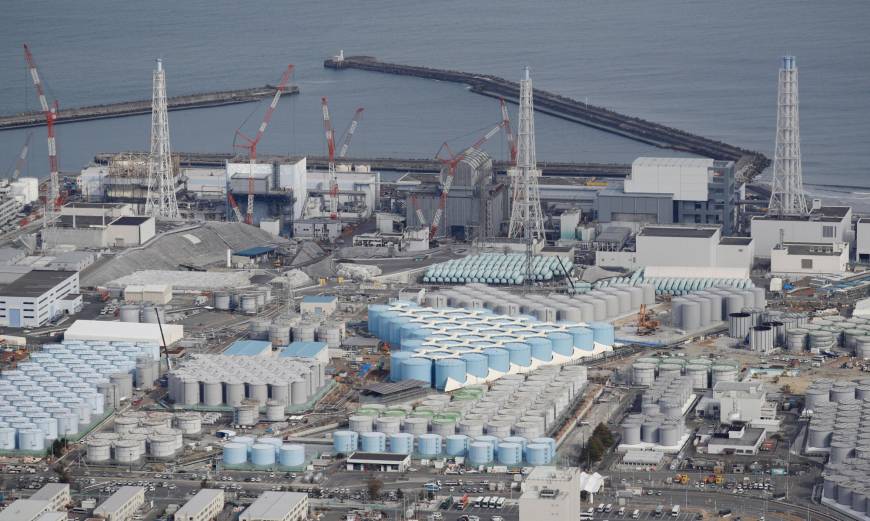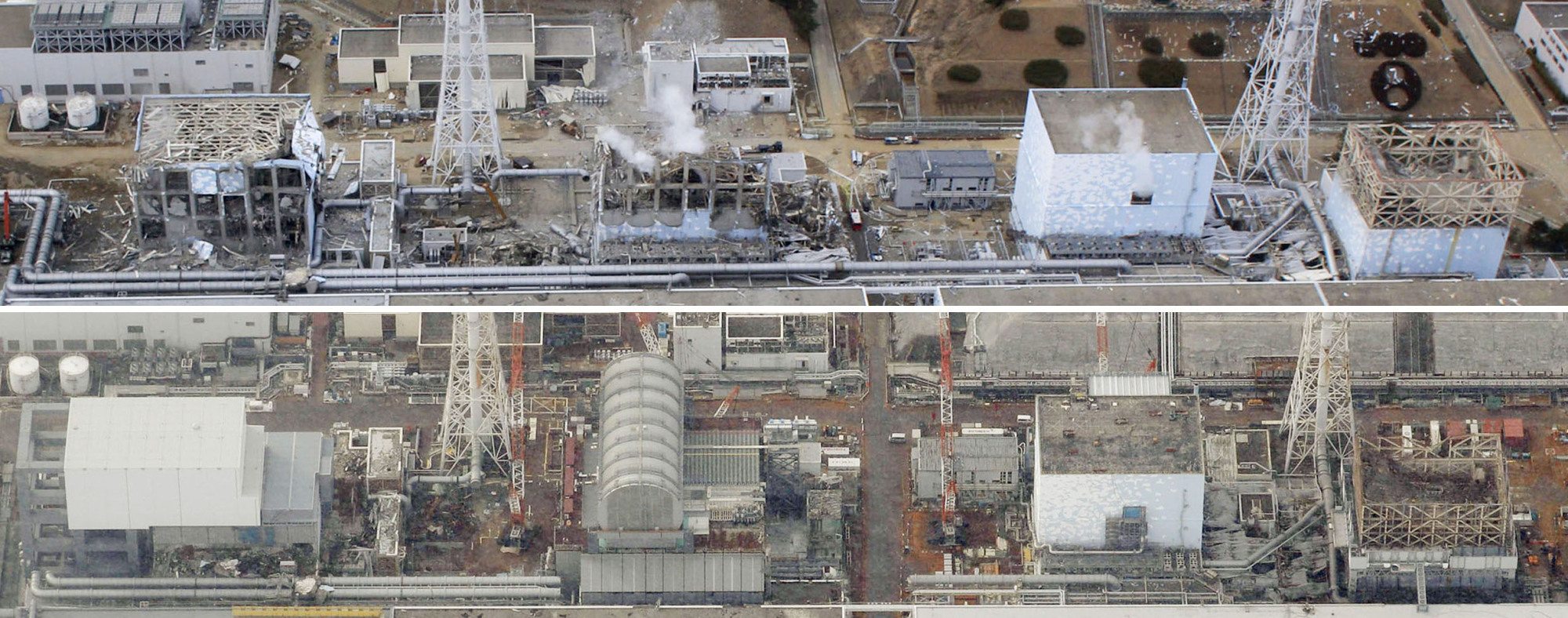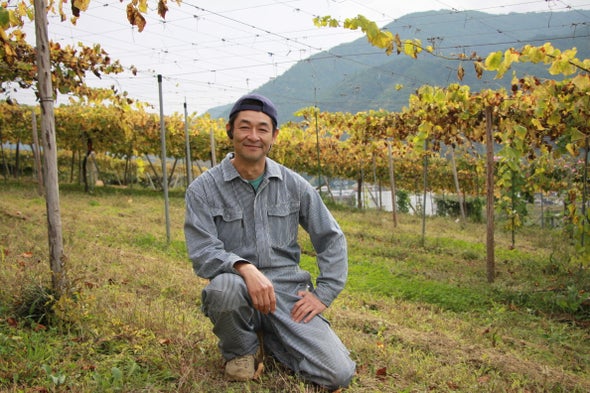Fukushima’s nuclear signature found in California wine
Atmospheric tests ended in 1980, when China finished its program, but the process has left a long-lasting nuclear signature on the planet. One of the most obvious signatures is cesium-137, a radioactive by-product of the fission of uranium-235.
After release into the atmosphere, cesium-137 was swept around the world and found its way into the food supply in trace quantities. Such an addition is rarely welcomed. But in 2001, the French pharmacologist Philippe Hubert discovered that he could use this signature to date wines without opening the bottles.
The technique immediately became a useful weapon in the fight against wine fraud—labeling young wines as older vintages to inflate their price. Such fraud can be spotted by various types of chemical and isotope analysis—but only after the wine has been opened, which destroys its value.
Cesium-137, on the other hand, allows noninvasive testing because it is radioactive. It produces distinctive gamma rays in proportion to the amount of isotope present. Dating the wine is a simple process of matching the amount of cesium-137 to atmospheric records from the time the wine was made. That quickly reveals any fraud. Indeed, if there is no cesium-137, the wine must date from after 1980.
There is one blip in this record, though. The Chernobyl disaster in 1986 bathed much of Europe, and other parts of the world, in a radioactive cloud that increased atmospheric levels of cesium-137 again. Hubert and colleagues can see this blip in their data from wines.
And that raises an interesting question about the Fukushima disaster of 2011, an accident of Chernobyl proportions caused by a meltdown at the Fukushima nuclear power plant in Japan following a huge earthquake and tsunami. It released a radioactive cloud that bathed North America in fissile by-products.
Is it possible to see the effects of the Fukushima nuclear disaster in California wines produced at the time?
Today we get an answer, thanks to a study carried out by Hubert and a couple of colleagues. “In January 2017, we came across a series of Californian wines (Cabernet Sauvignon) from vintage 2009 to 2012,” say Hubert and company.
This set of wines provides the perfect test. The Fukushima disaster occurred on March 11, 2011. Any wine made before that date should be free of the effects, while any dating from afterward could show them.
The team began their study with the conventional measurement of cesium-137 levels in the unopened bottles. That showed levels to be indistinguishable from background noise.
But the team was able to carry out more-sensitive tests by opening the wine and reducing it to ash by evaporation. This involves heating the wine to 100 degrees Celsius for one hour and then increasing the temperature to 500 degrees Celsius for eight hours. In this way, a standard 750-milliliter bottle of wine produces around four grams of ashes. The ashes were then placed in a gamma ray detector to look for signs of cesium-137.
Using this method, Hubert and his colleagues found measurable amounts of cesium-137 above background levels in the wine produced after 2011. “It seems there is an increase in activity in 2011 by a factor of two,” conclude the team.
That probably won’t be very useful for fraud detection in California wine—the levels of cesium-137 are barely detectable, and even then, only if the wine is destroyed.
But the result does show how nuclear disasters can have unexpected consequences long after the fact.
Ref:
arxiv.org/abs/1807.04340 : Dating of Wines with Cesium-137: Fukushima's Imprint
Fukushima No. 1 cleanup continues but radioactive water, and rumors, also prove toxic | The Japan Times
3/11/18
Hundreds of tanks can be seen holding filtered coolant water from the damaged Fukushima No. 1 nuclear power plant. Seven years after the meltdown crisis started, Tokyo Electric Power Company Holdings Inc. is struggling with an ever-increasing volume of radioactive water at the site. | KYODO
TOMIOKA, FUKUSHIMA PREF. – Seven years have passed since the core meltdowns occurred in March 2011 at the Fukushima No. 1 nuclear power plant, which shocked the world and fractured the local community.
During a media tour last month, a hazard map of the crippled nuclear plant was shown to reporters. Colors on the map showed the dramatic progress being made in efforts to recover from the triple meltdown crisis over the past seven years.
An aerial photo of the damaged nuclear reactors taken on March 20, 2011, (above) and another on Feb. 21 this year, show drastic changes over the past seven years after the 2011 meltdown crisis at the Fukushima No. 1 nuclear plant. From left: Reactors 4, 3, 2 and 1. | KYODO
According to the map, the plant’s compound is mainly designated as “green” zones where workers can walk around only with light work clothes and a disposable mask to cover the mouth and nose.
“This is a major achievement” considering the facilities’ radiation levels were so high soon after the nuclear accident that people couldn’t even walk into many areas, said Daisuke Hirose, a spokesman for a Tepco subsidiary in charge of decommissioning, during the press tour.
Yet despite largely reduced radiation levels the fear of unfounded rumors still weighs heavily on local people, making Tepco hesitant to answer a key question: How to dispose of ever-increasing volumes of radioactive water now being stored in hundreds of temporary water tanks on the compound?
Seven years after the crisis started, Tepco still needs to keep pouring water over the melted nuclear fuel. That water eventually mixes with tons of groundwater that continues to seep into the damaged reactor buildings.
To contain the ever-increasing volume of polluted water, 850 tanks have been built in the southwest part of the facility. They contain 1 million of the 1.1 million-ton total capacity, including 850,000 tons of so-called tritiated water.
The highly contaminated coolant water that directly contacted the fuel is sent to filtering systems and purified into a mix of water and tritium, a radioactive form of hydrogen that is difficult to separate from water.
Tritium, which also exists in the natural environment and is used for glow-in-the-dark lighting, is said to be relatively harmless to human health. Tritiated water is also produced at other nuclear plants as a byproduct of nuclear operations, and it is routinely dumped into the sea after it is diluted.
The Nuclear Regulation Authority has long urged Tepco to dump the water into the sea after diluting it to a density lower than the standards set by law. According to the NRA it is scientifically proven that, when diluted, the water has little impact on fisheries products.
But “this is not simply a technical discussion,” Hirose said. “Technically speaking, tritiated water in Fukushima No. 1 and that from any other plants would be the same. But we have to take into consideration the important aspect of reputational damage.”
Some local residents — fishermen in particular — fear it could cause groundless rumors of sea pollution and thus oppose the NRA’s recommendation, making it politically impossible for Tepco to discharge the water into the sea.
“If most people in general understood that tritium is relatively safe, we wouldn’t have to oppose the idea,” said Tadaaki Sawada, a spokesman for the Fukushima Prefectural Federation of Fisheries Cooperative Associations. “(But) after all, people would see it as yet another sign that Fukushima’s recovery is not going well and that Fukushima is still dangerous, ” he said.
He added that it is the government and Tepco’s responsibility to explain this to the people, rather than passing the buck to local fisheries, if they want to the critical decision to be made.
Tepco believes it’s possible to keep the radioactive water in the facility until January 2021. But “it’s not realistic to permanently keep this water” in tanks in the plant’s compound, Hirose of Tepco said.
According to the NRA, the average pressurized-water reactor for commercial use in Japan usually dumps 60 trillion becquerels of tritium a year into the sea. But releasing radioactive water and causing further reputational damage may slow the reconstruction efforts of nearby towns, whose recovery efforts have finally begun to make progress after evacuation orders were lifted, Sawada of the fisheries association said.
The town of Tomioka is one such Fukushima evacuation zone where the no-go restriction was lifted for some areas last April.
Located about 10 kilometers south of Fukushima No. 1, the town famous for its 2.2-km tunnel of cherry blossom trees hasn’t yet recovered its footing. According to the town only 458 people lived in Tomioka as of March 1 — a mere 3 percent of the 15,960 residents that were registered as of March 11, 2011. A Reconstruction Agency survey in December showed 46.8 percent of 3,203 Tomioka respondents said they do not plan to go back to their hometown.
While people in the fisheries association understand that tritiated water is relatively harmless to human health as Tepco claims, that doesn’t mean general consumers also feel safe about sea products once radioactive water from the nuclear disaster site is released into the ocean, Sawada said.
Since fiscal 2015, no sea products from near Fukushima Prefecture have exceeded the state-set safety limit of radiation levels on food of 100 becquerels per kilogram, according to the Fukushima Prefectural Government.
And last month Fukushima-based fishermen finally resumed exports of fisheries products, starting with shipments of flatfish to Thailand, for the first time since the nuclear disaster started.
“The speed is slow, but our reconstruction efforts are moving forward. We understand (the tritiated water’s) safety, but we cannot say it’s OK to release the water (from Fukushima No. 1) into the sea,” Sawada said.
Groundless fears about radiation may be becoming even more difficult to overcome now after seven years, especially as memories of the disaster are beginning to fade, an expert said. Although recovery efforts are progressing, many people outside the crisis-hit zone tend to fear the risks of radiation based on information from years ago because now fewer people follow up-to-date information about Fukushima’s reconstruction, said Nobuaki Yoshizawa, a research director at Mitsubishi Research Institute Inc. who analyses Fukushima’s reconstruction and public rumors on the nuclear crisis.
About 47 percent of 1,000 Tokyoites surveyed online by MRI in August indicated they haven’t received information about Fukushima’s reconstruction since the end of 2013, a finding that suggests the perceptions of many are still based on images seen around that time, according to the institute. This contrasts with the 30.5 percent of respondents who said they are still receiving up-to-date information.
“The important thing is to let people know about current progress and understand that reconstruction is certainly moving forward,” Yoshizawa said.
“If the release of tritiated water gives people the impression that the recovery (of Fukushima) is not going well, things may turn for the worse. It may be a difficult decision to make, but the important thing is to not further damage Fukushima’s image.”
Still, with work to assess the status of melted fuel rods inside the crippled reactor buildings progressing, along with endeavors to reduce risks in the working environment, the decommissioning effort is now ready to move on to the “real” work — removing radioactive materials from the three reactors that experienced core meltdowns, says Tepco’s Hirose.
Yet the work still has a long way to go, as Tepco estimates it will take 30 to 40 years to decommission the facility.
In January, Tepco for the first time located what seemed to be melted fuel debris at the bottom of the pressure vessel of reactor 2. Another investigation in July found what could be fuel debris hanging like icicles inside the water-filled reactor 3.
To identify the current status and location of melted fuel is considered the critical first step for deciding how to remove the debris from the crippled reactors and eventually clean up the site, Hirose said.
Tepco aims to start removing the melted fuel debris from inside the reactors by around 2021. In addition, Tepco plans to start removing spent and unused nuclear fuel assemblies from a storage pool inside the reactor 3 building as early as the middle of fiscal 2018. The utility aims to remove fuel from the pools of the other two reactor buildings in fiscal 2023.
All fuel rod assemblies at the reactor 4 building were removed in December 2014.






 ) shares his avocados with the neighborhood. Turns out they are the biggest avocados on Earth.
) shares his avocados with the neighborhood. Turns out they are the biggest avocados on Earth.  The prospect of being able to learn without any time impediment is very attractive. It seems that one only decides to leave 5D and reincarnate when one is ready for it so the learning possibilities are considerable. The caveat to this, however, is that the soul can only progress fractionally compared to the great progress possible once incarnate. So swot up on lots of subjects when one is in 5D but sooner or later the soul is going to feel the urge to get back to a physical body to progress on its soul journey, osit.
The prospect of being able to learn without any time impediment is very attractive. It seems that one only decides to leave 5D and reincarnate when one is ready for it so the learning possibilities are considerable. The caveat to this, however, is that the soul can only progress fractionally compared to the great progress possible once incarnate. So swot up on lots of subjects when one is in 5D but sooner or later the soul is going to feel the urge to get back to a physical body to progress on its soul journey, osit.